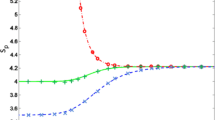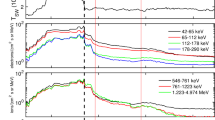Based on the analogy between WR nebulae, on one hand, and the heliosphere and expanding remnants of supernovae, on the other, the differential fluxes of energetic protons accelerated in shock waves to energies of 100 MeV are calculated. The standard analytic theory of acceleration under conditions of quasi-parallel magnetohydrodynamic shock waves was used. The acceleration time and the diffusion time for the energetic particles are in good agreement with one another and with the characteristic dynamic time for WR nebulae. A single-parameter formula is proposed for estimating the intensity (flux) of the accelerated particles under heliospheric conditions and is in good agreement with data from Voyager-1 at 1 MeV to within a factor of less than 2. The estimated fluxes for the conditions in WR nebulae are 4-6 orders of magnitude greater than the average over the galactic disk. The relatively low temperatures observed in the x-ray range for the perturbed regions near a shock wave may be related to the acceleration efficiency coefficient for the particles, as this has long been used to interpret analogous observations of supernova remnants. The resulting fluxes of energetic protons are used to estimate the radiation dose to complex carbon-containing systems in nebular dust and indicate that accelerated particles may play an important role in radiation-chemical transformations in WR nebulae.
Similar content being viewed by others
References
L. Drury, Rep. Prog. Phys. 46, 973 (1983).
A. Reimer, M. Pohl, and O. Reimer, Astrophys. J. 644, 1118 (2006).
A. Yeghikyan and H. Fahr, Astron. Astrophys. submitted (2017).
A. Moffat, in: W.-R. Hamann, A. Sander, and H. Todt, ed., Wolf-Rayet Star, Potsdam, Univ. Verlag (2015), p. 13.
J. Toalá, A. Marston, M. Guerrero, et al., Astrophys. J. 846, 76 (2017).
N. Soker, R. Rahin, E. Behar, et al., Astrophys. J. 725 (1910 (2010).
D. Ellison, A. Decourchelle, and J. Ballet, Astron. Astrophys. 429, 569 (2005).
E. Stone, A. Cummings, F. McDonald, et al., Science, 309 (2017 (2005).
H. Fahr and D. Verscharen, Astron. Astrophys. 487, L21 (2008).
H. Fahr and D. Verscharen, Astrophys. Space Sci. Trans. 6, 1 (2009).
H. Fahr, K. Scherer, M. Potgieter, et al., Astron. Astrophys. 486, L1 (2008).
K. Scherer and H. Fahr, Astron. Astrophys. 495, 631 (2009).
D. Verscharen and H. Fahr, Astrophys. Space Sci. Trans. 4, 51 (2008).
S. Chalov and H. Fahr, Solar Phys. 168, 369 (1996).
N. Smith, ARAA 52, 1 (2014).
A. Dworsky and H. Fahr, Astron. Astrophys. 353, L1 (2000).
F. Aharonian and A. Atoyan, Astron. Astrophys. 309, 917 (1996).
A. Yeghikyan, Astrophysics, 60, 374 (2017).
J. Richardson, J. Kasper, C. Wang, et al., Nature, 454, 7200, 63 (2008).
K. Scherer, H. Fichtner, S. Ferreira, et al., Astrophys. J. 680, L105 (2008).
M. Steffen, D. Schönberner, and A. Warnuth, Astron. Astrophys. 489, 173 (2008).
J. Toala and S. Artur, Mon. Not. Roy. Astron. Soc. 463, 4438 (2016).
A. Decourchelle, Mem. S. A. It. 79, 44 (2008).
H. Fahr, J. Richardson, and D. Verscharen, Astron. Astrophys. 579, A18 (2015).
H. Fahr and D. Verscharen, Astron. Astrophys. 587, L1 (2016).
E. Berezhko and D. Ellison, Astrophys. J. 526, 385 (1999).
A. Niedzielski and W. Skorzynski, Acta Astronomica, 52, 81 (2002).
P. Jenniskens, G. Baratta, A. Kouchi, et al., Astron. Astrophys. 273, 583 (1993).
J. Rizzo, J. Martín-Pintado, and J. Mangum, Astron. Astrophys. 366, 146 (2001).
A. Yeghikyan, ISRN Astron. Astrophys. 2011, id. 905015 (2011).
C. Cesarsky and H. Völk, Astron. Astrophys. 70, 367 (1978).
Y. Shchekinov, Astron. Rep. 49, 269 (2005).
T. Hendrix, R. Keppens, A. van Marle, et al., Mon. Not. Roy. Astron. Soc. 460, 3975 (2016).
J. Monnier, P. Tuthill, W. Danchi, et al., Astrophys. J. 655, 1033 (2007).
J. Ziegler, J. Biersack, and U. Littmark, The Stopping and Range of Ions in Solids, Pergamon Press, NY (2003).
C. Casiraghi, A. Ferrari, and J. Robertson, Phys. Rev. B, 72, 085401 (2005).
S. Marchenko and A. Moffat, Mon. Not. Roy. Astron. Soc. 468, 2416 (2017).
A. Scott, W. Duley, and G. Pinho, Astrophys. J. 489, L193 (1997).
M. Otsuka, F. Kemper, J. Cami, et al., Mon. Not. Roy. Astron. Soc. 437, 2577 (2014).
J. Zhen, P. Castellanos, D. Paardekooper, et al., Astrophys. J. 797, L30 (2014).
F. Cataldo, G. Strazzulla, and S. Iglesias-Groth, Mon. Not. Roy. Astron. Soc. 394, 615 (2009).
Author information
Authors and Affiliations
Corresponding author
Additional information
Translated from Astrofizika, Vol. 61, No. 4, pp. 523-539 (November 2018).
Rights and permissions
About this article
Cite this article
Yeghikyan, A. On the Possibility of Particle Acceleration in Shock Waves in WR Nebulae. Astrophysics 61, 469–482 (2018). https://doi.org/10.1007/s10511-018-9551-8
Received:
Accepted:
Published:
Issue Date:
DOI: https://doi.org/10.1007/s10511-018-9551-8




